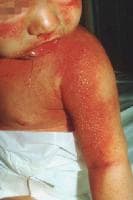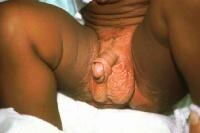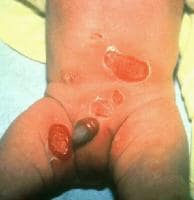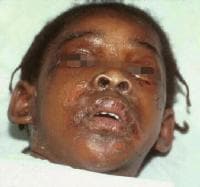Staphylococcal scalded skin syndrome (SSSS) presents as a red rash followed by diffuse epidermal exfoliation.
A prodromal localized S aureus infection of the skin, throat, nose, mouth, umbilicus, or GI tract occurs. Such an infection often is not apparent before the SSSS rash appears.
The following may be noted:
A prodromal localized S aureus infection of the skin, throat, nose, mouth, umbilicus, or GI tract occurs. Such an infection often is not apparent before the SSSS rash appears.
The following may be noted:
- General malaise
- Fever
- Irritability
- Skin tenderness
Physical
The following may be noted:- Fever, although patients may be afebrile
- Tenderness to palpation
- Warmth to palpation
- Facial edema
- Perioral crusting
- Most patients do not appear severely ill.
- Dehydration may be present and significant.
- Nikolsky sign (gentle stroking of the skin causes the skin to separate at the epidermis)[20, 21]
 Staphylococcal scalded skin syndrome. Photograph by David Effron, MD, FACEP.
Staphylococcal scalded skin syndrome. Photograph by David Effron, MD, FACEP.  Staphylococcal scalded skin syndrome. Photograph by David Effron, MD, FACEP. Bullae are flaccid and ill defined. See the image below.
Staphylococcal scalded skin syndrome. Photograph by David Effron, MD, FACEP. Bullae are flaccid and ill defined. See the image below. Staphylococcal scalded skin syndrome. Photograph by David Effron, MD, FACEP. Exfoliation of skin, which may be patchy or sheetlike in nature, is noted. See the images below.
Staphylococcal scalded skin syndrome. Photograph by David Effron, MD, FACEP. Exfoliation of skin, which may be patchy or sheetlike in nature, is noted. See the images below. Staphylococcal scalded skin syndrome. Photograph by David Effron, MD, FACEP
Staphylococcal scalded skin syndrome. Photograph by David Effron, MD, FACEP
No comments:
Post a Comment